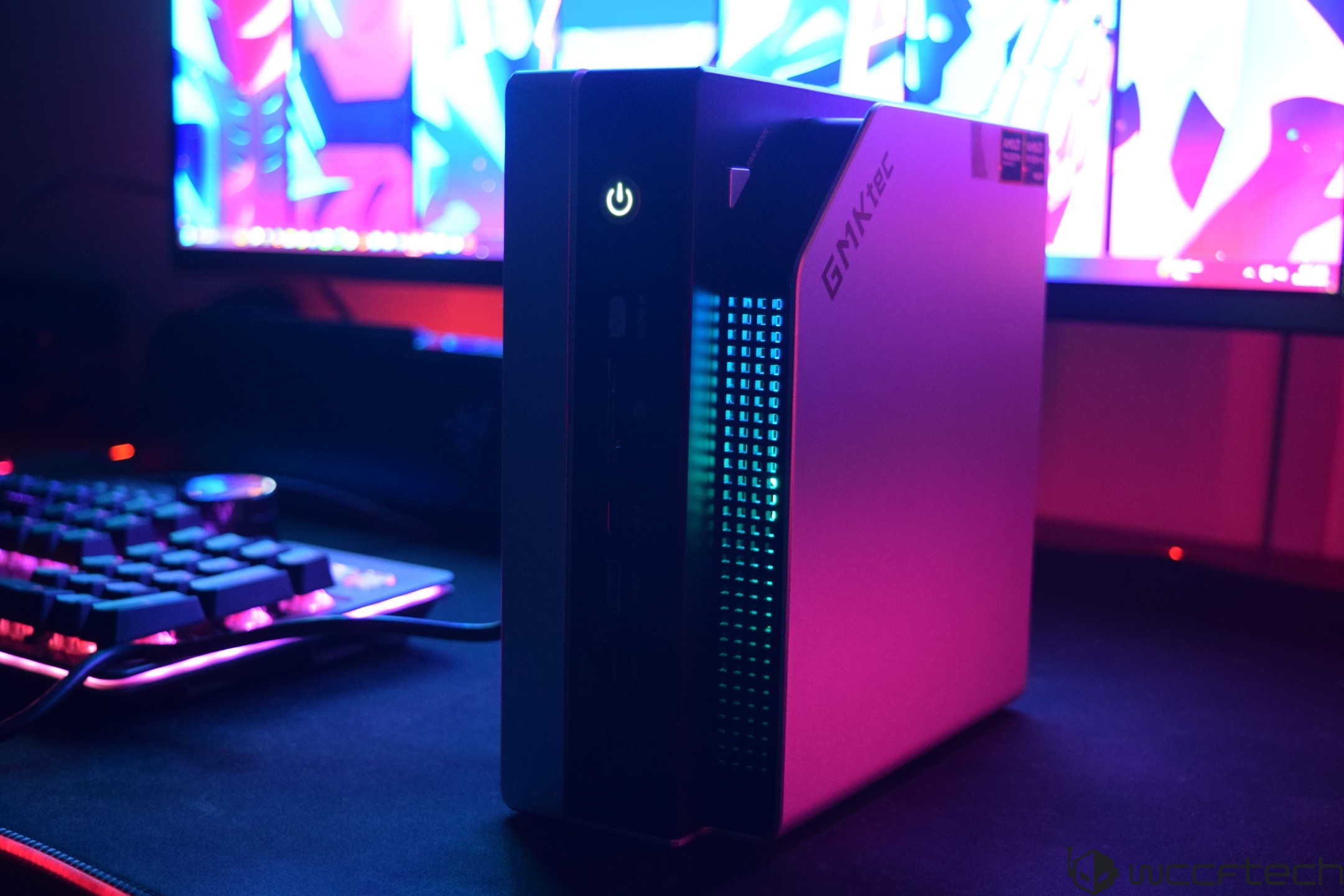
GMKtec has been making Mini PCs for years now. They are based out of the technology hub of Shenzen, China, and have maintained strategic partnerships with AMD, Intel & Microsoft, and currently offer a wide array of solutions, all the way from entry-level to enthusiast-grade designs based on mobility chips from AMD & Intel.
The latest offering from GMKtek that targets high-end users is the Evo X2, a small form factor design that is equipped with AMD’s most powerful SoC to date, the Ryzen AI MAX+ 395 (internally codenamed Strix Halo). This SoC takes everything we know about Strix “Ryzen AI 300” series, takes it into overdrive mode with a chiplet architecture, and offers incredibly powerful specs.
The GMKtec EVO X2 not only houses the top Strix Halo APU, but it also features a wide array of IO and a strong set of internal specs, such as storage and memory. We’ve been waiting to get our hands on AMD’s Ryzen AI MAX+ chips, and now that we finally have our hands on one thanks to GMKtec, we can finally see if this product really holds up to its “Halo” design.
GMKtec EVO X2 Mini PC – Specifications At A Glance
In terms of specifications, the GMKtec EVO X2 is equipped with the AMD Ryzen AI MAX+ 395 APU. This is the flagship processor within the Strix Halo lineup, which is purpose-built as a Mini Workstation platform, and has a lot to talk about, so let’s get started.
The AMD Ryzen AI MAX+ 395 APU features 16 cores in total with 32 threads, and is based on TSMC’s 4nm process technology. Unlike the standard Strix lineup, which mixes Zen 5 and Zen 5C cores, the Strix Halo family features the full-fledged, high-performance Zen 5C cores. These 16 cores are packaged within two Core Complexes or CCX chiplets, each housing 8 cores and 32 MB of L3 cache for a total of 64 MB & 16 MB of L2 on the CPU side.
The CPU has a base frequency of 3.0 GHz. The Zen 5 cores clock up to 5.1 GHz and have a TDP rating of 55W at default, which can be configured down to 45W and up to 120W. The SoC is featured on the FP11 platform and is BGA in design.
For the iGPU, AMD is using its latest RDNA 3.5 architecture, which is a slightly upgraded & more efficient variant of the RDNA 3 architecture.
The AMD Ryzen AI MAX+ 395 features a massive integrated GPU core on the same interposer that is located within its IOD chiplet. This GPU is massive because it features 40 compute units, up from 12 CUs on the top Ryzen AI 300 “Strix” APU. The GPU clocks in at a maximum frequency of 2900 MHz.
The RDNA 3.5 iGPUs support all the latest APIs and AI Frameworks. Plus, RDNA 3.5 also supports the latest upscaling and frame generation features, such as FSR 2, FSR 3, FSR 3 Frame-Gen, and AFMF2, while adding advanced latency reduction technologies such as Anti-Lag 2. It’s one of the fastest iGPUs on the market right now.
On the NPU side, the AMD Ryzen AI MAX+ 395 is equipped with an XDNA 2 NPU, which offers a peak TOPS of 50 and supports all the latest AI frameworks. This is the fastest NPU in terms of AI TOPS in the market right now, and the only thing that comes close is the 48 TOPS of the Lunar Lake lineup. But since there’s also a massive GPU at disposal, the SoC offers a total AI compute of 126 TOPs.
AMD Ryzen AI 300 APUs:
CPU NameArchitectureCores / ThreadsClock Speeds (Max)Cache (Total)AI CapabilitiesiGPUTDP Ryzen AI 9 HX PRO 375Zen 5 / Zen 5C12/242.0 / 5.1 GHz36 MB / 24 MB L385 AI TOPs (55 TOPS NPU)Radeon 890M (16 CU @ 2.9 GHz)28W (cTDP 15-54W) Ryzen AI 9 HX 375Zen 5 / Zen 5C12/242.0 / 5.1 GHz36 MB / 24 MB L3Radeon 890M (16 CU @ 2.9 GHz)28W (cTDP 15-54W) Ryzen AI 9 HX 370Zen 5 / Zen 5C12/242.0 / 5.1 GHz36 MB / 24 MB L385 AI TOPs (55 TOPS NPU)Radeon 890M (16 CU @ 2.9 GHz)28W (cTDP 15-54W) Ryzen AI 9 HX PRO 370Zen 5 / Zen 5C12/242.0 / 5.1 GHz36 MB / 24 MB L380 AI TOPs (50 TOPS NPU)Radeon 890M (16 CU @ 2.9 GHz)28W (cTDP 15-54W) Ryzen AI 7 365Zen 5 / Zen 5C10/202.0 / 5.0 GHz30 MB / 20 MB L380 AI TOPs (50 TOPS NPU)Radeon 880M (12 CU @ 2.9 GHz)28W (cTDP 15-54W) Ryzen AI 7 PRO 360Zen 5 / Zen 5C8/162.0 / 5.0 GHz24 MB / 16 MB L380 AI TOPs (50 TOPS NPU)Radeon 880M (12 CU @ TBD GHz)28W (cTDP 15-54W)
With the internals of the SoC covered, let’s talk about the rest of the specifications. First, we have the memory, which comes in the form of 64 GB of LPDDR5x. The Mini PC comes pre-configured and pre-soldered in 96 GB and 128 GB options too. The LPDDR5x modules on the GMKtek EVO X2 operate at 8000 MT/s across a 256-bit wide bus interface. This wider memory bus is available on AMD’s Ryzen AI MAX+ APUs, allowing for up to 256 GB/s of bandwidth. This is essential since the GPU itself doesn’t feature any Infinity Cache onboard, which means that the LPDDR5x subsystem is what will be used as the primary means of communication. LPDDR5x is fast, but we expect that AMD will move to the newer LPDDR6 standards as soon as the next-gen Halo chips arrive to further offset the bandwidth requirements. The RDNA 3.5 architecture also has a decent memory compression algorithm, which can reduce some of the bandwidth needs.
The biggest advantage of Strix Halo APUs is that you can dedicate large pools of memory to the iGPU, making them a strong solution for LLMs. Our solution can dedicate up to 32 GB of memory to the iGPU alone, showing it as a GPU with 32 GB of available VRAM. The higher-end EVO X2 configurations can also be configured with up to 96 GB of VRAM for the GPU (the system retains at least 16 GB of memory for the system). This makes for a strong AI solution and an even better gaming platform where graphics memory limitations can be bypassed by simply dedicating more system memory to the iGPU.
Our review unit was equipped with a 1 TB Crucial PCIe Gen4 SSD with a dedicated heatsink. The EVO X2 has two M.2 Gen4x4 slots, which can be equipped with 4 TB each for up to 8 TB of memory.
IO includes two USB 10 Gbps Type-A ports, 1 USB4 Type-C port, 1 SD card reader, 1 3.5mm audio jack, on the front, while the back includes two USB 2.0 Type-A ports, 1 USB 10 Gbps Type-A port, 1 USB4 Type-C port, 1 DP 1.4 port, 1 HDMI 2.1 port, another 3.5mm audio jack, a DC-in port, and a Kensington lock port.
Talking a little bit about the BIOS, it is very barebones for the EVO X2. The first page lists down the various information about the Mini PC and has one important setting, the “Power Mode Select”. This gives three options: Performance mode with a 120W target, Balanced mode with an 85W target, and Quiet mode with a 54W target. In the advanced menu, you can find the graphics options from where you can enable UMA to set a custom frame buffer size for the GPU.
There are other CPU options too in the Advanced menu, but nothing that can further overclock the chip itself. The memory configuration options let you select “Auto” or manual clock speeds. These only go below the factory 8000 MT/s speeds. And finally, we have the fan speed control options. These can also be set using a fan mode button on the Mini PC itself.
GMKteck EVO X2 Mini PC – Unboxing & A Closer Look
The GMKtec EVO X2 comes inside a large package with a gold GMKtec logo engraved on the front.
The back of the box has some basic specifications that list the specific configuration for this model. We got the AMD Ryzen AI MAX+ 395 variant with 64 GB of memory and a 1 TB SSD.
Within the box, you can find the Mini PC in its old compartment, along with a guide/warranty booklet, the power adapter, the power cable, and an HDMI cable. The adapter is made by Huntkey with the specific model number being “HKA230195A2-0A7” and offers up to 230.1W of power to the system.
GMKtec’s Mini PCs really do stand out from the rest of the market offerings, with a stylish dual-tone design. The front cover is all metallic with a silver hue, while the chassis is a mix of an outer plastic shell with an internal aluminum frame. The Mini PC is a bit on the chunky side, but for good reasons, as we will get to in a bit.
There are four exhaust vents/ports on the EVO X2. One under the top frame, two around the rear IO, and one on the sides. These ensure that the PC receives adequate airflow and remains cool with higher heat dissipation through the vents.
The front I/O on the GMKtec EVO X2 Mini PC comes with a Power Button, a Performance Mode toggle key, one SD card reader that supports SDXC, one USB 4.0 Type-C port, 2 USB 3.2 10 Gbps Type-A ports, 1 3.55mm audio jack, and a Fan-Mode button on the very top.
The back I/O on the GMKtec EVO X2 includes a DC IN 5525 connector, one 3.5mm audio jack, 1 USB 3.2 10 Gbps Type-A port, 1 USB4 Type-C port, 1 DP 1.4 (8.1 Gbps / HBR3) port, 1 HDMI 2.1 (FRL @ 8 Gbps) port, and two USB 2.0 ports.
The top Fan-Mode button can be used to change the fan speed. Interestingly, GMKtec lists this as a “Light Button” on its official page, but we weren’t able to see any difference in RGB lighting when pressing the button.
To access the internals, you have to unscrew the two rubber feet at the bottom of the chassis. These are easy to remove.
Upon removing the top cover, you are first greeted by a large aluminum frame which houses a red-colored PCB and an 80mm fan with RGB illumination. This provides cooling to the backside of the PCB, which also houses the dual SSDs.
The back of the PCB has two PCIe Gen4 x4 slots, one of which is populated with a Crucial Gen4 1 TB SSD. Each slot can house 4 TB of storage capacity. There’s also a MediaTek wireless card which offers Wi-Fi 7 & BT5.4 support. The unpopulated SSD slot states that the PC is running the v1.05 BIOS.
The other side of the motherboard houses the AMD Ryzen AI MAX+ 395 SoC, the LPDDR5x memory, and the power delivery. All of this is located under a large heatsink with two blower-style fans.
For cooling, GMKtec is using its latest Max 3.0 thermal system, which includes two blower-style fans that are attached to a full copper heatsink. The heatsink has a large surface area for dissipating heat and has a large copper baseplate that attaches over the three chiplets on the Ryzen AI MAX+ 395 SoC, & also the LPDDR5x memory. There are also subsections within the heatsink that make contact with the VRMs.
There are at least 26 VRM phases on the motherboard itself. The PCB features a very distinctive red PCB, which we haven’t seen in a while, except some ASUS motherboards. It also feels a lot like a design that’s similar to current-gen consoles with soldered memory and a large SoC taking the center stage.
Finally, we have the RGB illumination of the EVO X2. It’s subtle and provides a good look.
GMKtek EVO X2 Mini PC – CPU Performance
We start by comparing the 3DMark CPU Profile tests.
In Blender, we used the standard monster, junkshop, and classroom tests for evaluation. The AI MAX+ 395 crushes the standard Strix with a lead of 80% despite there being just a 21.5% power difference, & 33.3% difference in core count. At 120W, it reaches a whole new level, being over twice as fast.
In CPU-Z, we tested the single-thread and multi-thread performance. While the single-thread performance is on par with the Ryzen AI 9 HX 370, which also hits a max frequency of 5.1 GHz, the multi-core score is where we see the raw power of Strix Halo, claiming a 49.1% lead at 54W, 86% lead at 85W, and a 105% lead at 120W.
For Cinebench 2024, we once again compared the single-core and multi-core performance. This is the same result, with Ryzen AI MAX+ 395 not only beating the 70W Ryzen AI 9 HX 370 at 54W, but offering close to double the performance with a 120W TDP.
In Geekbench 6, we used the full-suite benchmark to evaluate the performance. Same story here, too.
In UL Procyon’s office test, standard office use-cases were evaluated. The office tests show a solid increase in performance for Strix Halo, but not as significant as the previous entries.
Lastly, we have the WinRAR benchmark test. Here, the CPU combined with fast LPDDR5x-8000 memory provides a superb uplift in performance.
GMKtec EVO X2 – AI Synthetic Performance
Next up, we have our first AI benchmarks for the latest Intel and AMD CPUs. First up, we have the Geekbench AI benchmark numbers, which are as follows:
For UL Procyon, we again see Intel’s latest CPUs and its various AI accelerators, such as the NPU and the GPU, offering better performance capabilities than the Ryzen AI offerings.
With 126 TOPs of AI compute at its disposal, the GPU and NPU combination provides strong AI numbers. Plus, we did mess around with some local chatbots and Amuse, and the dedicated memory option for the GPU enables the EVO X2 as a solid Mini AI Workstation.
GMKtec EVO X2 Mini PC – GPU Synthetic Performance
Now we are going to look at the GPU performance, and before we present to you the gaming numbers, we first have to see how the performance fares in synthetic benchmarks. For this purpose, we first want to outline the single-precision FLOPs each iGPU offers. Intel’s Arc and AMD’s Radeon series are based on entirely different architectures, and despite the FLOPS of the Radeon iGPU being higher, it doesn’t necessarily mean that the Radeon iGPU will be faster. But with that said, the following is how the two chips compare:
Strix Halo’s Radeon 8060S iGPU with 40 RDNA 3.5 compute units offers almost 27 TFLOPs of FP32 compute, a 3.6x increase over the 12 RDNA 3.5 compute units featured in the Radeon 890M iGPU. Comparatively, that’s 3.33x more cores.
In 3DMark Speed Way, the Radeon 8060S scores a 4x lead over the entry-level iGPUs, offering close to RTX 4060/RTX 5050 (discrete graphics cards) levels of RT performance.
For 3DMark Steel Nomad, we get to see our first non-RT performance of these iGPUs. Once again, this is almost a 4x lead for the Radeon 8060S, almost matching the RTX 4060/RTX 5050 graphics cards.
In 3DMark Port Royal, the Radeon 8060S is up to 3.5x faster than the entry-level iGPUs. Once again, very close to the RTX 4060/RTX 5050 graphics cards.
In 3DMark Time Spy, the Radeon 8060S is over 3.5x faster than the entry-level iGPUs. The chip exceeds the performance offered by RTX 4060/RTX 5050 graphics cards.
For Fire Strike, Intel offers great performance even on DX11 APIs, which is a good showcase, as many games still run DX11. The Radeon 8060S crushes the entry-level iGPUs and puts out 10-15% better performance than the RTX 4060/RTX 5050 graphics cards.
Lastly, we have 3DMark Night Raid, where the Radeon 8060S manages to come close to even the flagship RTX 5090 Blackwell (Mobile) GPU.
GMKtec EVO X2 Mini PC – HD Gaming Performance
With the synthetic performance out of the way, we can start taking a look at pure gaming numbers, and we start off our testing spree with Cyberpunk 2077 running at Medium Preset at 1080p with Balanced XeSS/FSR upscaling.
In Forza Horizon 5, we only ran the game using Quality Upscaling at the Medium Preset at 1080p.
In F1 24, we used the High Preset at 1080p.
In Horizon Zero Dawn at the “Favor Quality” preset, we used the FSR 2 upscaling set to Balanced.
Metro Exodus also runs great, offering up to 101 FPS using the High Preset and RT set to Normal at 1080p.
Lastly, we have The Callisto Protocol, which runs flawlessly at the provided settings.
Borderlands 4 is a heavy game to run, but the Radeon 8060S can manage a solid 60 FPS at 1080p High using Quality upscaling (FSR3) while enabling frame-gen nets you over 100 FPS. The entry-level iGPUs barely manage 30 FPS even with frame-gen enabled at the same settings.
Lastly, we chose to see how the Radeon 8060S performs when we crank up the settings to the max in each of the tested titles at 1080p. Looking at the number, we can see superb performance, which should be enough to play the same games at 1440p and even 4K using a mix of high settings, upscaling, and frame-gen.
GMKtec EVO X2 Mini PC – Power & Thermals
Next, we can see the power consumption of the latest Mini PCs.
Following thermals, we have temperatures:
The 120W profile can make the EVO X2 a bit toasty, working at 85C+ temps, but the 85W and 54W profiles keep it in a more stable range. Following is the clock operation at each of the given TDP modes:
Conclusion – Ryzen AI MAX+ Is The Game-Changer
The Future is Fusion, which used to be AMD’s motto a decade ago when they first ventured into APUs. Back in the day, I used to believe that this Fusion was a reference to combining a powerful CPU with a high-end GPU, all on a single chip. The exascale APU patents from several years ago brought us closer to that dream, but it would take years of engineering and a solid framework to build a chip that offered the best of both worlds. Now in 2025, that chip is finally here in the form of Strix Halo or Ryzen AI MAX.
When AMD officially took the lid off Strix Halo earlier this year, I was excited to get my hands on one, as I’ve always been excited for new APUs. Strix Halo isn’t just a regular APU or SoC; it combines the best of both worlds, bringing up to 16 Zen 5 cores together with a massive GPU with 40 compute units based on the latest RDNA 3.5 architecture. The chip also offers the latest IO capabilities, and these are the things that are the most exciting.
AMD Strix Halo Achieves Next-Level SoC Performance
The 16 Zen 5 cores offer tremendous productivity and multi-threaded performance. It might not be a 1-1 copy of the Ryzen 9 9950X, but it is strong at its given power budget. Then we have the Radeon 8060S iGPU, which is as mighty as you can expect. This iGPU crunches through all games we threw at it at 1080p, giving enough headroom for gamers to go the extra mile with 1440p or 2160p resolutions.
The memory subsystem of the Strix Halo SoC also makes it a potent solution for AI, handling chonkier LLMs with ease, with these chips dedicating up to 96 GB to the GPU alone. This also works in favor of games where you’re no longer restricted to measly 8 GB dedicated memory; instead, you can select a pool size from 512 MB, up to 96 MB, and run games perfectly even at higher resolutions. The LPDDR5X-8000 256-bit config also provides a decent amount of bandwidth, but I can already see where AMD is going to go next.
For gaming, we have the following recommendation for Strix Halo users:
1080p AAA Gaming: Playable With Max Settings (Some with Upscaling set to Quality Mode)
1440p AAA Gaming: Playable With High Settings (Some with Upscaling+Frame-Gen set to Quality Mode)
2160p AAA Gaming: Playable With Med/High Settings (Upscaling Set To Quality/Balanced With Frame-Gen)
We can expect similar compute units based on newer architectures, but coupled with better memory sub-systems such as LPDDR6, and the possible inclusion of a dedicated cache, such as Infinity Cache, to further mitigate the GPU’s bandwidth requirements. AMD has got hold of the packaging expertise required to create a Halo-class SoC; now it’s time for them to innovate and accelerate their future.
GMKtec’s EVO X2 Is Massively Powerful, Tidy, & Offers Solid IO Given Its Small Size
While the AMD Strix Halo is insanely good, we also have a lot of positive things to say about the EVO X2 from GMKtec. It’s small, it’s fast, and it has a lot of useful and modern IO. You get two USB4 ports, a 2.5GbE LAN port, Wi-Fi 7+BT5.4 wireless capabilities, and other essentials, making it enough for the majority of PC users.
The chassis itself is quite a looker, with its RGB illumination, a dual-fan cooler for the Strix Halo SoC, and another dedicated fan for the SSDs. As for the upgradability, the two SSD slots can be equipped with up to 4 TB each, but the memory, unfortunately is soldered to the motherboard. So you have to pre-select a configuration which comes in 64 GB, 96 GB, and 128 GB flavors.
Now for thermals and power, the BIOS lets you configure between the three modes easily, and there’s also a performance switch button which you can access from the front. I’d say the 85W is correctly labeled as Balanced as it doesn’t offset you with a huge performance loss and keeps you in proximity with the Performance 120W mode. The 54W mode is also great for low-power workloads, and even with a low TDP, the raw specs for the Ryzen AI MAX+ 395 still manage to beat 70-80W configured standard Strix APUs.
Thermals are on the hotter side with the temps exceeding 85 °C at the full performance mode of 120W and even 75 °C with the 85W mode. Only the 54W mode yields lower than 70 °C temps. The 120W and 85W TDP modes also make the fan spin much faster, so much so that you can hear it going into supersonic mode, but that’s a necessity since otherwise, you’ll remain thermally throttled with the clocks dropping down to the 3 GHz level.
As for pricing, the GMKtec EVO X2 64 GB is currently listed for $1499 US, which is reasonable given that laptops with the same specs and AI MAX+ 395 are over $2000 US. Now, you can build yourself a fantastic PC for $1500 US, such as a 5060 Ti or 9060 XT with a 9800X3D, 32 GB of memory, 1 TB SSD, and a 700W PSU, but that’s not the point of the EVO X2. It’s small, it’s a singular chip solution, and it can dedicate large pools of memory to the GPU, making it a solid mini AI workstation or a gaming machine.
So with the Ryzen AI MAX+ 395 “Strix Halo” SoC, AMD delivers on the “Future is Fusion” promise, making the world’s most powerful SoC with its Zen 5 CPU and RDNA 3.5 GPU architecture. It’s a fantastic chip for all your AI, Gaming, and Productivity needs, and machines such as the GMKtec EVO X2 showcase us a vibrant future for such Halo SoCs.
Things we liked/disliked about the GMKtec EVO X2 Mini PC:



